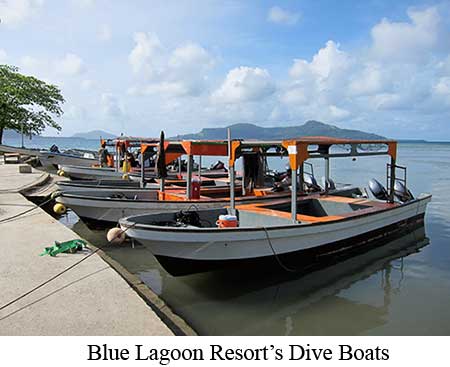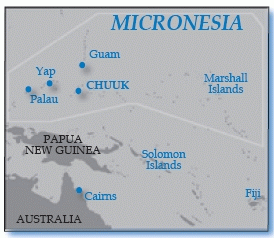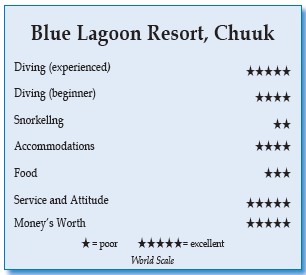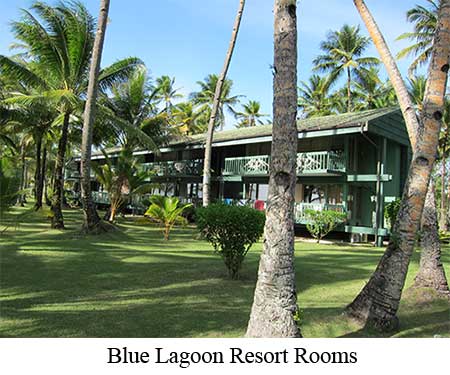Blue Lagoon Resort, Chuuk, MicronesiaContents of this Issue: Blue Lagoon Resort, Chuuk, Micronesia Another Chuuk Option: the Truk Odyssey Flying to Micronesia? Options to Avoid United Belize Diving Services, Caye Caulker, Belize Bad Mistakes Dead Divers Make: Part II Why Not Make the Costa Concordia a Diver’s Paradise? DEPP: Off the Recommended List Five Websites That Makes Dive Travel Easier “Another” Recall for Aqua Lung’s SureLock Weight Pockets A Bad Dive Weekend Coast to Coast Humans Have Changed Stingrays’ Ways Editorial Office: Ben Davison Publisher and Editor Undercurrent 3020 Bridgeway, Suite 102 Sausalito, CA 94965 the non-liveaboard experience from the April, 2013 issue of Undercurrent
Dear Fellow Diver: After a trying trip involving four plane connections, I arrived in Chuuk International Airport ("Truk" officially became "Chuuk" in 1990) with my luggage still in Guam and my sanity barely intact. But there was one more adventure to endure. It was past midnight and raining hard when the resort staff loaded us into a Toyota RAV4. There were no streetlights, and the main road was an obstacle course, filled with ruts, holes and unmarked excavations, all hidden by the downpour. The ride was as rough as they come, but fortunately our driver knew where to steer the car. (When we returned to the airport on a sunny day, I gulped at the unmarked open trenches, as deep as 30 feet, on either side of the road.) At last, my partner and I reached the resort and were greeted with refreshing coconut milk, while the staff transported our luggage to our room. I crashed and hoped for a better tomorrow. I got it for the next nine days.
My first dive was on the Fujikawa Maru ("maru" is a designation for non-military ships), beginning with the bridge at 30 feet. I could easily see fighter planes and big artillery shells in her holds; though deteriorated by the sea, they were easily identifiable. It was simple to forget I was diving a ship, it looked more like an oddly -shaped flat reef. On the bow, clownfish nestled in its anemone shelter. A juvenile pipefish lounged around the coral, as did clams and sponges on the deck. Moorish idols were everywhere. A small gray reef shark passed by, the first and only of my trip -- disappointing because I had read the lagoon was full of them.
My buddy and I decided in advance not to dive the first day in order to get at least halfway through the fog of jet lag. We visited the dive shop after the 9 a.m. boats departed to show our C-cards, and for my buddy to confirm he would have the EAN 80 in a stage bottle, which he requires for a medical condition. The shop had it ready, and check-in was efficient and friendly. And our luggage arrived! Next day, we placed our dive gear outside our room, and when we arrived at the marina, it had already been assembled on their 20-foot boat, similar to a whaler, with two Yamaha outboards. A rectangular wooded seating area was built along all four sides of the hold, and shaded with a canopy. Dive gear was stored in the rear and front; there were no tank racks. There was a jug of drinking water, and a small rinse bucket for cameras was available on request. I couldn't see any safety gear on board. Most resort guests were divers with one of two organized groups -- one from Australia, the other from New Jersey -- who kept to their own boats and schedules. The non-group dive boat had nine divers -- three from Europe, one from South America and five Americans. Estos was extremely knowledgeable about the lagoon and its conditions, and gave us a good briefing at each dive site. His sidekick drove the boat, hauled our gear to the seat and placed it behind us, holding it until we were in our BCs. I would backroll into the water (which was in the mid-80s in March), and before climbing up the removable ladder, hand up my fins, BC and weight belt. Both Estos and his mate were upbeat, always helpful, and spoke workable English.
My "superior" room on the second floor had a cathedral ceiling, fan, two comfortable queen beds, porch with table and chairs, TV and DVD player, two armchairs, chest of drawers and a bathroom. It was quite comfortable and wellcleaned each day. The resort is powered by generators that are often switched on and off, occasionally causing the AC to not come back on -- unpleasant when you wake up sweaty at 2 a.m. In response to minor AC and plumbing problems, maintenance men arrived promptly, but they never could do more than provide lukewarm water in the shower. Since Chuuk isn't brimming with eateries, we had all our meals in the indoor dining room or outdoor bar. When traveling to dive resorts in the past, I've noted that few members of organized dive groups extend themselves to others. They're perfectly content to bond only with fellow travelers, as they did here, keeping to their own tables and friends. Calling ourselves the outcasts, my buddy and I ate with people from our dive boat. Meals had Asian (termed "Japanese" on the menu), local and American options. For breakfast, my dive buddy enjoyed a vacation from his usual heart-healthy breakfast and dined on scrambled eggs, roasted potatoes and sausage links. Lunch and dinner choices included pasta, burgers, steak, Asian noodle dishes, soups, salads, fish and chicken or combinations thereof. Some dinner choices were unusual; one was shish kabobs of marinated pork, chicken and liver, served with rice and plantains. Picky eaters can stick with grilled local fish and rice. The availability of fruits and vegetables depended on what arrived on the flights. My travel agent had arranged for us to pre-pay breakfast ($10 per person, per day) but not lunch or dinner -- a good plan, because our lunch and dinner checks never reached what we would have had to prepay for those meals. A small market near the dive shop carries bottled water, soda, ice cream, chips, and frozen pizza at lower prices than the resort's gift shop. While a few divers lingered in the bar after dinner, I would usually watch an episode of Homeland on my iPad Mini and hit the sack. Internet access was sporadic, and only available in the lobby and dining room. Typically, we departed at 9 a.m. for a dive, returned for lunch, then departed at 1 p.m. for the second dive, returning about 4 p.m. To get a third afternoon dive in, we did two dives some mornings before returning to the resort, but twice we returned so late that the dining room had closed. Once we got a full lunch menu in the bar, the second time the food staff skipped their break and opened the dining room to serve us lunch. The friendly staff members always said hello, knew where we wanted to sit for meals, and even knew what we wanted to eat before we ordered. The dive shop also provided great service. When the mouthpiece on my primary regulator broke and the one on my octopus leaked, they quickly replaced the former and reattached the latter at no charge. They carry Scubapro parts, and Mares rental gear. The gas-mixing operation was first rate. My buddy was able to return a used stage bottle and have it filled while he waited. One morning, the scheduled dive was San Francisco Maru, which starts at 150 feet. The dive shop only offered 80- and 100-cu. ft. tanks, and to me, diving that deep on a single is stretching the safety level. So I switched to another boat and, wearing 100 cu-ft tanks, my buddy and I dropped in on the Shinokoku Maru, where we were rewarded with the sight of tanks and field artillery on the deck. Deck guns were encrusted with corals and populated by small fish. In one of the holds, human bones were a grim reminder of the last World War. On many wrecks, sake bottles were a mainstay, and artifacts were artfully arranged on the decks or within the holds. I guess that's necessary for easy viewing and reducing damage to the ships, but sometimes it looked just too arranged, such as a deck area with pieces of crockery set up as if on a table. Some ships had huge holes in their decks or sides, blown open by U.S. bombs or torpedoes. It was awe-inspiring to look up 100 feet from inside a ship to see the blue water above, surrounded by the edges of the deck. But no soft coral and very few fish; it was mostly diving clean steel. Besides my lone reef shark sighting, I also saw a single spotted eagle ray and one turtle.
During one surface interval, Estos took us to his home island of Tonoas so that he could vote in the local election. We took a brief island walking tour ($3 per person), which included the abandoned high school, a former Japanese administration building, and a small museum of Japanese pillboxes. The woman who took my money reminded me of "Bloody Mary" from Tales of the South Pacific -- all she needed were some shrunken heads. After seeing multiple wrecks full of holds and holes, I was ready to dive a reef. The resort does that for snorkelers, but the trip wasn't scheduled until my last day, though I bet they would have accommodated me had I spoken up earlier. By the time I requested a reef dive, the winds were too rough for the long ride. Before we departed, the dive shop treated us to a special lunch served in a pavilion overlooking the lagoon. At the end of the meal, Estos awarded each of us with a nice printed certificate -- testimony that we had dived the Chuuk Lagoon. I will mount mine and hang it in the den, a fine memento of the trip to see the underwater remains of our last World War. Chuuk is a schlep, but if you're a history buff and a wreck-dive lover, it's worth it. For some of us, a land-based operation is the way to go. For others, a liveaboard will be a better option. -- F.N.J.
|

I want to get all the stories! Tell me how I can become an Undercurrent Online Member and get online access to all the articles of Undercurrent as well as thousands of first hand reports on dive operations world-wide
| Home | Online Members Area | My Account |
Login
|
Join
|
| Travel Index |
Dive Resort & Liveaboard Reviews
|
Featured Reports
|
Recent
Issues
|
Back Issues
|
|
Dive Gear
Index
|
Health/Safety Index
|
Environment & Misc.
Index
|
Seasonal Planner
|
Blogs
|
Free Articles
|
Book Picks
|
News
|
|
Special Offers
|
RSS
|
FAQ
|
About Us
|
Contact Us
|
Links
|
3020 Bridgeway, Ste 102, Sausalito, Ca 94965
All rights reserved.

 Chuuk Atoll is everyone's idea of a tropical paradise,
and it's at the end of the world, with fewer than
100 rooms available. While many hardcore divers prefer
liveaboards here, I'm prone to seasickness, so my buddy
and I opted for the Blue Lagoon Resort. The grounds are
beautifully maintained,
with the
requisite coconut
palms and hammocks,
but they are also,
shall we say, "decorated"
with WWII
anti-aircraft guns
and aircraft propellers. Truk Lagoon was
Japan's main base
in the South Pacific
when Operation
Hailstone, a threeday
attack by U.S. forces in February 1944, sent 60 ships and
275 airplanes to the bottom of the lagoon,
making it the world's biggest ship graveyard.
That's what I had come to see.
Chuuk Atoll is everyone's idea of a tropical paradise,
and it's at the end of the world, with fewer than
100 rooms available. While many hardcore divers prefer
liveaboards here, I'm prone to seasickness, so my buddy
and I opted for the Blue Lagoon Resort. The grounds are
beautifully maintained,
with the
requisite coconut
palms and hammocks,
but they are also,
shall we say, "decorated"
with WWII
anti-aircraft guns
and aircraft propellers. Truk Lagoon was
Japan's main base
in the South Pacific
when Operation
Hailstone, a threeday
attack by U.S. forces in February 1944, sent 60 ships and
275 airplanes to the bottom of the lagoon,
making it the world's biggest ship graveyard.
That's what I had come to see. The afternoon's dive was at a "Betty" bomber at 60 feet. Estos, my divemaster,
led me to the plane's engines, scattered a short way from the fuselage.
The wings are encrusted with growing coral colonies in a variety of colors,
and they nurtured the most colorful fish life I saw on that trip. But
of course, Chuuk is about wrecks, and during my week of two-tank dive days, I
went to wrecks at 60 to 110 feet, with several dives going deeper, including
one with a deck starting at 150 feet.
The afternoon's dive was at a "Betty" bomber at 60 feet. Estos, my divemaster,
led me to the plane's engines, scattered a short way from the fuselage.
The wings are encrusted with growing coral colonies in a variety of colors,
and they nurtured the most colorful fish life I saw on that trip. But
of course, Chuuk is about wrecks, and during my week of two-tank dive days, I
went to wrecks at 60 to 110 feet, with several dives going deeper, including
one with a deck starting at 150 feet. The wind, while refreshing at the
resort, could cause four-foot waves in the lagoon. During the rough 20- to 35-minute ride to a site, I was splashed
and soaked with seawater. Once it rained so hard, it felt like hail was hitting
my back. Some divers wore their masks (our first mate added a snorkel) to
deal with the rougher rides. Considering the two liveaboards in the lagoon --
the Truk Odyssey and the Thorfinn -- I was a bit envious.
The wind, while refreshing at the
resort, could cause four-foot waves in the lagoon. During the rough 20- to 35-minute ride to a site, I was splashed
and soaked with seawater. Once it rained so hard, it felt like hail was hitting
my back. Some divers wore their masks (our first mate added a snorkel) to
deal with the rougher rides. Considering the two liveaboards in the lagoon --
the Truk Odyssey and the Thorfinn -- I was a bit envious. Estos was very lenient; divers are on their own in terms of how deep
they go and for how long. Once, while I was edging through the interior of
the Shinkoku Maru, there was an annoying traffic jam because people in front
wouldn't move along, but for the most part,
divers -- even the photographers -- were
considerate enough. Those wishing to have
a "tour" would meet Estos underwater, but
divers were free to do their own thing if
they were experienced and competent. Most
fit that bill, except for a 68-year-old guy
from Colorado who had but 10 dives after
being certified 10 years ago. He couldn't
even read his pressure gauge. Luckily, he
was good with his air consumption, perhaps
because he lived in the Rockies. At the San
Francisco Maru, I was the first to run low on air, so Estos brought him over and signaled that we would go up together, but he started swimming upward. Estos grabbed his fin and pulled him back down. Back on
the boat, I asked him what he knew about ascending. "You ascend as fast as your
bubbles go up," was his reply. "Uh, they changed that a while back," I told him.
Estos was very lenient; divers are on their own in terms of how deep
they go and for how long. Once, while I was edging through the interior of
the Shinkoku Maru, there was an annoying traffic jam because people in front
wouldn't move along, but for the most part,
divers -- even the photographers -- were
considerate enough. Those wishing to have
a "tour" would meet Estos underwater, but
divers were free to do their own thing if
they were experienced and competent. Most
fit that bill, except for a 68-year-old guy
from Colorado who had but 10 dives after
being certified 10 years ago. He couldn't
even read his pressure gauge. Luckily, he
was good with his air consumption, perhaps
because he lived in the Rockies. At the San
Francisco Maru, I was the first to run low on air, so Estos brought him over and signaled that we would go up together, but he started swimming upward. Estos grabbed his fin and pulled him back down. Back on
the boat, I asked him what he knew about ascending. "You ascend as fast as your
bubbles go up," was his reply. "Uh, they changed that a while back," I told him. Divers Compass: Blue Lagoon Resort accepts MasterCard and Visa,
but you'll pay a 3.7 percent surcharge for the privilege of
using it . . . Book the pre-paid breakfast plan, like I did;
my buddy and I were there for nine days, and our total bill
for lunch, dinner, snacks and drinks was just over $400 . . .
There's a box at the front desk to leave tips for staff, but I
tipped the boat crew and my housekeeper separately . . . If you
have delicate intestines, beware of both the tap and local bottled
water (I fell victim to the chemicals used to purify the
island's water) and bring your preferred stomach medications . . . For additional
reference about my dives, I brought the excellent "Franko's Chuuk Lagoon
Dive Map" (purchase at
Divers Compass: Blue Lagoon Resort accepts MasterCard and Visa,
but you'll pay a 3.7 percent surcharge for the privilege of
using it . . . Book the pre-paid breakfast plan, like I did;
my buddy and I were there for nine days, and our total bill
for lunch, dinner, snacks and drinks was just over $400 . . .
There's a box at the front desk to leave tips for staff, but I
tipped the boat crew and my housekeeper separately . . . If you
have delicate intestines, beware of both the tap and local bottled
water (I fell victim to the chemicals used to purify the
island's water) and bring your preferred stomach medications . . . For additional
reference about my dives, I brought the excellent "Franko's Chuuk Lagoon
Dive Map" (purchase at 